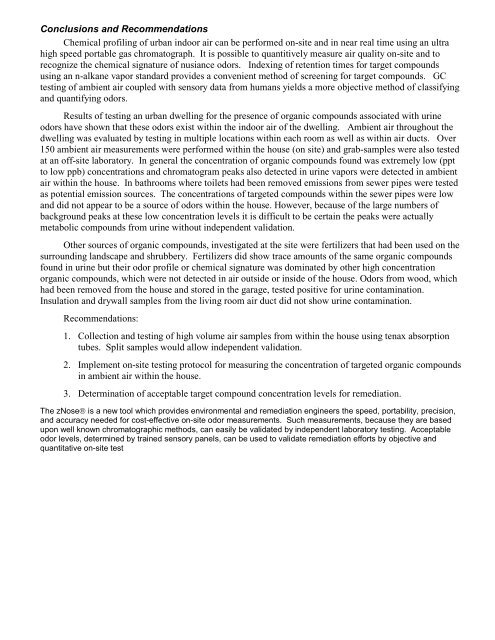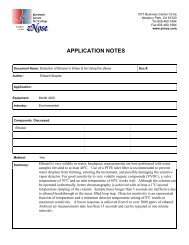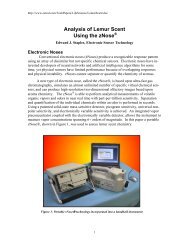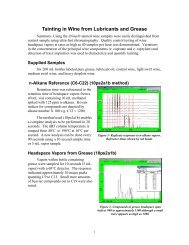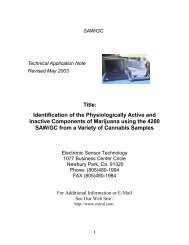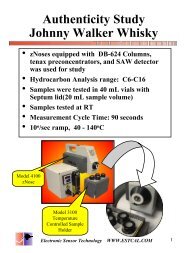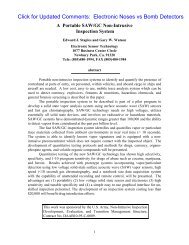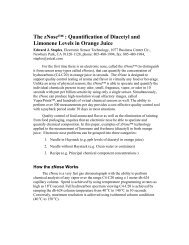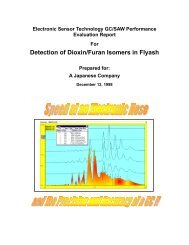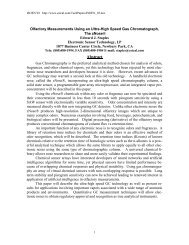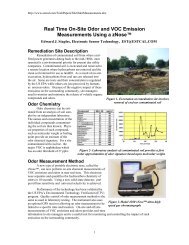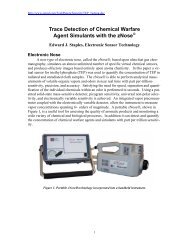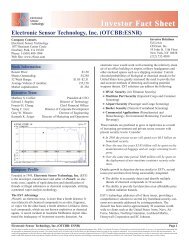Urine Odors in an Urban Dwelling - Electronic Sensor Technology
Urine Odors in an Urban Dwelling - Electronic Sensor Technology
Urine Odors in an Urban Dwelling - Electronic Sensor Technology
You also want an ePaper? Increase the reach of your titles
YUMPU automatically turns print PDFs into web optimized ePapers that Google loves.
Conclusions <strong>an</strong>d Recommendations<br />
Chemical profil<strong>in</strong>g of urb<strong>an</strong> <strong>in</strong>door air c<strong>an</strong> be performed on-site <strong>an</strong>d <strong>in</strong> near real time us<strong>in</strong>g <strong>an</strong> ultra<br />
high speed portable gas chromatograph. It is possible to qu<strong>an</strong>titively measure air quality on-site <strong>an</strong>d to<br />
recognize the chemical signature of nusi<strong>an</strong>ce odors. Index<strong>in</strong>g of retention times for target compounds<br />
us<strong>in</strong>g <strong>an</strong> n-alk<strong>an</strong>e vapor st<strong>an</strong>dard provides a convenient method of screen<strong>in</strong>g for target compounds. GC<br />
test<strong>in</strong>g of ambient air coupled with sensory data from hum<strong>an</strong>s yields a more objective method of classify<strong>in</strong>g<br />
<strong>an</strong>d qu<strong>an</strong>tify<strong>in</strong>g odors.<br />
Results of test<strong>in</strong>g <strong>an</strong> urb<strong>an</strong> dwell<strong>in</strong>g for the presence of org<strong>an</strong>ic compounds associated with ur<strong>in</strong>e<br />
odors have shown that these odors exist with<strong>in</strong> the <strong>in</strong>door air of the dwell<strong>in</strong>g. Ambient air throughout the<br />
dwell<strong>in</strong>g was evaluated by test<strong>in</strong>g <strong>in</strong> multiple locations with<strong>in</strong> each room as well as with<strong>in</strong> air ducts. Over<br />
150 ambient air measurements were performed with<strong>in</strong> the house (on site) <strong>an</strong>d grab-samples were also tested<br />
at <strong>an</strong> off-site laboratory. In general the concentration of org<strong>an</strong>ic compounds found was extremely low (ppt<br />
to low ppb) concentrations <strong>an</strong>d chromatogram peaks also detected <strong>in</strong> ur<strong>in</strong>e vapors were detected <strong>in</strong> ambient<br />
air with<strong>in</strong> the house. In bathrooms where toilets had been removed emissions from sewer pipes were tested<br />
as potential emission sources. The concentrations of targeted compounds with<strong>in</strong> the sewer pipes were low<br />
<strong>an</strong>d did not appear to be a source of odors with<strong>in</strong> the house. However, because of the large numbers of<br />
background peaks at these low concentration levels it is difficult to be certa<strong>in</strong> the peaks were actually<br />
metabolic compounds from ur<strong>in</strong>e without <strong>in</strong>dependent validation.<br />
Other sources of org<strong>an</strong>ic compounds, <strong>in</strong>vestigated at the site were fertilizers that had been used on the<br />
surround<strong>in</strong>g l<strong>an</strong>dscape <strong>an</strong>d shrubbery. Fertilizers did show trace amounts of the same org<strong>an</strong>ic compounds<br />
found <strong>in</strong> ur<strong>in</strong>e but their odor profile or chemical signature was dom<strong>in</strong>ated by other high concentration<br />
org<strong>an</strong>ic compounds, which were not detected <strong>in</strong> air outside or <strong>in</strong>side of the house. <strong>Odors</strong> from wood, which<br />
had been removed from the house <strong>an</strong>d stored <strong>in</strong> the garage, tested positive for ur<strong>in</strong>e contam<strong>in</strong>ation.<br />
Insulation <strong>an</strong>d drywall samples from the liv<strong>in</strong>g room air duct did not show ur<strong>in</strong>e contam<strong>in</strong>ation.<br />
Recommendations:<br />
1. Collection <strong>an</strong>d test<strong>in</strong>g of high volume air samples from with<strong>in</strong> the house us<strong>in</strong>g tenax absorption<br />
tubes. Split samples would allow <strong>in</strong>dependent validation.<br />
2. Implement on-site test<strong>in</strong>g protocol for measur<strong>in</strong>g the concentration of targeted org<strong>an</strong>ic compounds<br />
<strong>in</strong> ambient air with<strong>in</strong> the house.<br />
3. Determ<strong>in</strong>ation of acceptable target compound concentration levels for remediation.<br />
The zNose® is a new tool which provides environmental <strong>an</strong>d remediation eng<strong>in</strong>eers the speed, portability, precision,<br />
<strong>an</strong>d accuracy needed for cost-effective on-site odor measurements. Such measurements, because they are based<br />
upon well known chromatographic methods, c<strong>an</strong> easily be validated by <strong>in</strong>dependent laboratory test<strong>in</strong>g. Acceptable<br />
odor levels, determ<strong>in</strong>ed by tra<strong>in</strong>ed sensory p<strong>an</strong>els, c<strong>an</strong> be used to validate remediation efforts by objective <strong>an</strong>d<br />
qu<strong>an</strong>titative on-site test<br />
Detection of 2-Methylisoborneol <strong>an</strong>d Geosm<strong>in</strong> <strong>in</strong> Pond Water<br />
Us<strong>in</strong>g the zNose®


